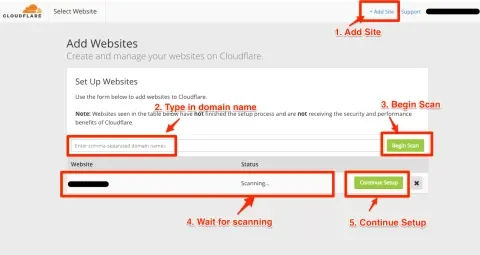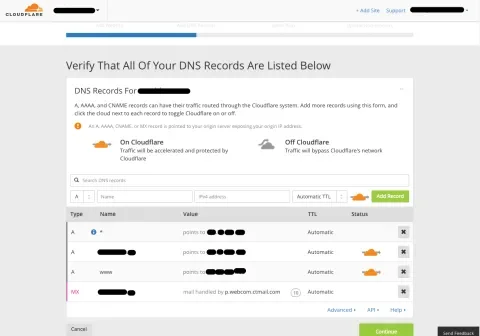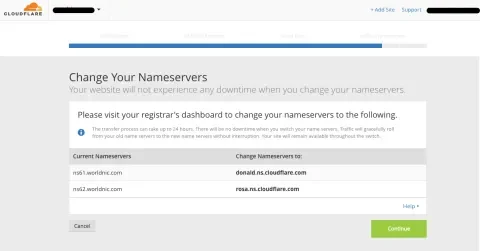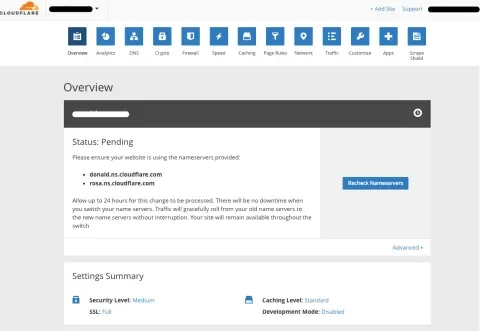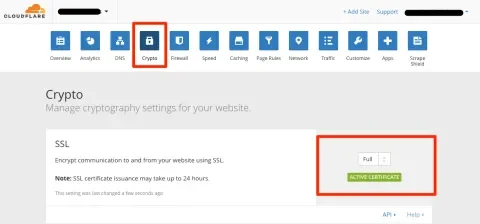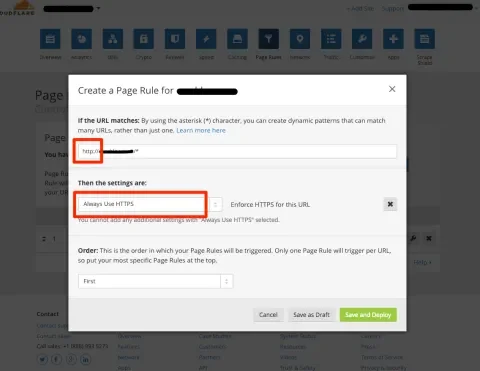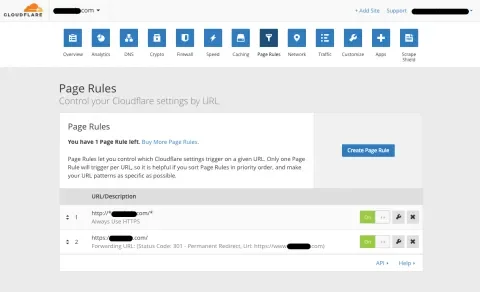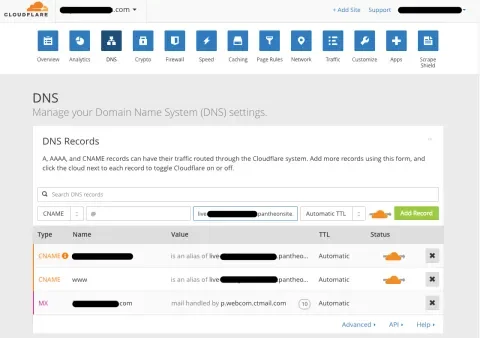This is a continuation of a series of articles about HTTPS, continuing from HTTPS Everywhere: Security is Not Just for Banks. If you own a website and understand the importance of serving sites over HTTPS, the next task is to figure out how to migrate a HTTP website to HTTPS. In this article, I’ll walk through an easy and inexpensive option for migrating your site to HTTPS, especially if you have little or no control over your website server or don't know much about managing HTTPS.
A Github Pages Site
I started with the simplest possible example. I have a website hosted by a free, shared hosting service, Github Pages, that doesn’t directly provide SSL for custom domains, I have no shell access to the server, and I just wanted to get my site switched to HTTPS as easily and inexpensively as possible. I used an example from the Cloudflare blog about how to use Cloudflare SSL for a Github Pages site.
Services like Cloudflare can provide HTTPS for any site, no matter where it is hosted. Cloudflare is a Content Delivery Network (CDN) that stands in front of your web site to catch traffic before it gets to your origin website server. A CDN provides caching and efficient delivery of resources, but Cloudflare also provides SSL certificates, and they have a free account option to add any domain to a existing SSL certificate for no charge. With this alternative there is no need to purchase an individual certificate, nor figure out how to get it uploaded and signed. Everything is managed by Cloudflare. The downside of this option is that the certificate will be shared with numerous other unrelated domains. Cloudflare has higher tier accounts that have more options for the SSL certificates, if that’s important. But the free option is an easy and inexpensive way to get basic HTTPS on any site.
It’s important to note that adding another server to your architecture means that content makes another hop between servers. Now, instead of content going directly from your origin website server to the user, it goes from the the origin website server to Cloudflare to the user. The default Cloudflare SSL configuration will encrypt traffic between end users and the Cloudflare server (front-end traffic), but not between Cloudflare and your origin website server (back-end traffic). They point out in their documentation that back-end traffic is much harder to intercept, so that might be an acceptable risk for some sites. But for true security you want back-end traffic encrypted as well. If your origin website server has any kind of SSL certificate on it, even a self-signed certificate, and is configured to manage HTTPS traffic, Cloudflare can encrypt the back-end traffic as well with a “Full SSL” option. If the web server has an SSL certificate that is valid for your specific domain, Cloudflare can provide even better security with the “Full SSL (strict)” option. Cloudflare also can provide you with a SSL certificate that you can manually add to your origin server to support Full SSL, if you need that.
Step 1. Add a new site to Cloudflare
I went to Cloudflare, clicked the button to add a site, typed in the domain name, and waited for Cloudflare to scan for the DNS information (that took a few minutes). Eventually a green button appeared that said ‘Continue Setup’.
Step 2. Review DNS records
Next, Cloudflare displayed all the existing DNS records for my domain.
Network Solutions is my registrar (the place where I bought and manage my domain). Network Solutions was also my DNS provider (nameserver) where I set up the DNS records that indicate which IP addresses and aliases to use for my domain. Network Solutions will continue to be my registrar, but this switch will make Cloudflare my DNS provider, and I’ll manage my DNS records on Cloudflare after this change.
I opened up the domain management screen on Network Solutions and confirmed that the DNS information Cloudflare had discovered was a match for the information in my original DNS management screen. I will be able to add and delete DNS records in Cloudflare from this point forward, but for purposes of making the switch to Cloudflare I initially left everything alone.
Step 3. Move the DNS to Cloudflare
Next, Cloudflare prompted me to choose a plan for this site. I chose the free plan option. I can change that later if I need to. Then I got a screen telling me to switch nameservers in my original DNS provider.
On my registrar, Network Solutions, I had to go through a couple of screens, opting to Change where domain points, then Domain Name Server, point domain to another hosting provider. That finally got me to a screen where I could input the new nameservers for my domain name.
Back on Cloudflare, I saw a screen like the following, telling me that the change was in progress. There was nothing to do for a while, I just needed to allow the change to propagate across the internet. The Cloudflare documentation assured me that the change should be seamless to end users, and that seemed logical since nothing had really changed so far except the switch in nameservers.
Several hours later, once the status changed from Pending to Active, I was able to continue the setup. I was ready to configure the SSL security level. There were three possible levels. The Flexible level was the default. That encrypts traffic between my users and Cloudflare, but not between Cloudflare and my site’s server. Further security is only possible if there is an SSL certificate on the origin web site server as well as on Cloudflare. Github pages has a SSL certificate on the server, since they provide HTTPS for non-custom domains. I selected the Crypto tab in Cloudflare to choose the SSL security level I wanted and changed the security level to Full.
Step 4. Confirm that HTTPS is Working Correctly
What I had accomplished at this point was to make it possible to access my site using HTTPS with the original HTTP addresses still working as before.
Next, it was time to check that HTTPS was working correctly. I visited the production site, and manually changed the address in my browser from HTTP://www.example.com to HTTPS://www.example.com. I checked the following things:
- I confirmed there was a green lock displayed by the browser.
- I clicked the green lock to view the security certificate details (see my previous article for a screenshot of what the certificate looks like), and confirmed it was displaying a security certificate from Cloudflare, and that it included my site’s name in its list of domains.
- I checked the JavaScript console to be sure no mixed content errors were showing up. Mixed content occurs when you are still linking to HTTP resources on an HTTPS page, since that invalidates your security. I’ll discuss in more detail how to review a site for mixed content and other validation errors in the next article in this series.
Step 5. Set up Automatic Redirection to HTTPS
Once I was sure the HTTPS version of my site was working correctly, I could set up Cloudflare to handle automatic redirection to HTTPS, so my end users would automatically go to HTTPS instead of HTTP.
Cloudflare controls this with something it calls “Page Rules,” which are basically the kinds of logic you might ordinarily add to an .htaccess file. I selected the “Page Rules” tab and created a page rule that any HTTP address for this domain should always be switched to HTTPS.
Since I also want to standardize on www.example.com instead of example.com, I added another page rule to redirect traffic from HTTPS://example.com to HTTPS://www.example.com using a 301 redirect.
Finally, I tested the site again to be sure that any attempt to access HTTP redirected to HTTPS, and that attempts to access the bare domain redirected to the www sub-domain.
A Drupal Site Hosted on Pantheon
I also have several Drupal sites that are hosted on Pantheon and wanted to switch them to HTTPS, as well. Pantheon has instructions for installing individual SSL certificates for Professional accounts and above, but they also suggest an option of using the free Cloudflare account for any Pantheon account, including Personal accounts. Since most of my Pantheon accounts are small Personal accounts, I decided to set them up on Cloudflare as well.
The setup on Cloudflare for my Pantheon sites was basically the same as the setup for my Github Pages site. The only real difference was that the Pantheon documentation noted that I could make changes to settings.php that would do the same things that were addressed by Cloudflare’s page rules. Changes made in the Drupal settings.php file would work not just for traffic that hits Cloudflare, but also for traffic that happens to hit the origin server directly. Pantheon’s documentation notes that you don’t need to provide both Cloudflare page rules and Drupal settings.php configuration for redirects. You probably want to settle on one or the other to reduce future confusion. However, either, or both, will work.
These settings.php changes might also be adapted for Drupal sites not hosted on Pantheon, so I am copying them below.
// From https://pantheon.io/docs/guides/cloudflare-enable-https/#drupal
// Set the $base_url parameter to HTTPS:
if (defined('PANTHEON_ENVIRONMENT')) {
if (PANTHEON_ENVIRONMENT == 'live') {
$domain = 'www.example.com';
}
else {
// Fallback value for development environments.
$domain = $_SERVER['HTTP_HOST'];
}
# This global variable determines the base for all URLs in Drupal.
$base_url = 'https://'. $domain;
}
// From https://pantheon.io/docs/redirects/#require-https-and-standardize-domain
//Redirect all traffic to HTTPS and WWW on live site:
if (isset($_SERVER['PANTHEON_ENVIRONMENT']) &&
($_SERVER['PANTHEON_ENVIRONMENT'] === 'live') &&
(php_sapi_name() != "cli")) {
if ($_SERVER['HTTP_HOST'] != 'www.example.com' ||
!isset($_SERVER['HTTP_X_SSL']) ||
$_SERVER['HTTP_X_SSL'] != 'ON' ) {
header('HTTP/1.0 301 Moved Permanently');
header('Location: https://www.example.com'. $_SERVER['REQUEST_URI']);
exit();
}
}
There was one final change I needed to make to my Pantheon sites that may or may not be necessary for other situations. My existing sites were configured with A records for the bare domain. That configuration uses Pantheon’s internal system for redirecting traffic from the bare domain to the www domain. But that redirection won’t work under SSL. Ordinarily you can’t use a CNAME record for the bare domain, but Cloudflare uses CNAME flattening to support a CNAME record for the bare domain. So once I switched DNS management to Cloudflare’s DNS service, I went to the DNS tab, deleted the original A record for the bare domain and replaced it with a CNAME record, then confirmed that the HTTPS bare domain properly redirected to the HTTPS www sub-domain.
Next, A Deep Dive
Now that I have basic SSL working on a few sites, it’s time to dig in and try to get a better understanding about HTTPS/SSL terminology and options and see what else I can do to secure my web sites. I’ll address that in my next article, HTTPS Everywhere: Deep Dive Into Making the Switch.

